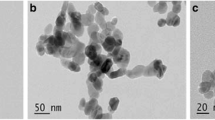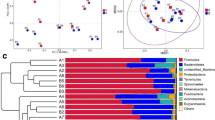Abstract
This study was conducted to investigate the effect of zinc chitosan chelate (CS-Zn) on zinc transporter expression and content of tissue zinc in weaned piglets. A total of 90 weaned pigs (Duroc × Landrace × Yorkshire) were randomly allocated to treatment groups with supplementation of 100 mg/kg zinc as ZnSO4, 100 mg/kg zinc as mixture of ZnSO4 and chitosan, or 100 mg/kg zinc as CS-Zn, respectively. After 30 days of trial, 18 piglets (six pigs per treatment) were killed and the samples of duodenal mucosa were taken for analysis of zinc transporter mRNA expressions and protein abundance. The results show that CS-Zn more effectively increases (p < 0.05) the average daily gain (ADG) and serum zinc concentration. Zinc concentration in the liver and kidney did not differ between treatments. The mRNA expressions of ZnT1, ZIP4, and ZIP5 in CS-Zn treatment were all upregulated (p < 0.05) than ZnSO4 or mixture of ZnSO4 and chitosan groups. ZnT1 abundance was greater (p < 0.05) with CS-Zn as compared with ZnSO4 and mixture of ZnSO4 and chitosan treatments, whereas ZIP4 and ZIP5 abundance was higher (p < 0.05) in ZnSO4 group. The results indicate that CS-Zn is more effective in serum zinc accumulation, and it might regulate zinc homeostasis by affecting zinc transporter mRNA expression and absorption mechanism might be different with ZnSO4.

Similar content being viewed by others
References
Lichten LA, Cousins RJ (2009) Mammalian zinc transporters: nutritional and physiologic regulation. Annu Rev Nutr 29:153–176
Bhowmik D, Chiranjib KP (2010) A potential medicinal importance of zinc in human health and chronic. Int J Pharm 1(1):05–11
Gowda NKS, Pal DT, Gupta R, Sampath KT, Editors. 2011. Annual report of All India Coordinated Research Project on “Improvement of feed resources and nutrient utilization in raising animal production”. Report no. 2. Bangalore: NIANP (ICAR); p. 9–11
Carlson MS, Boren CA, Wu C, Huntington CE, Bollinger DW, Veum TL (2004) Evaluation of various inclusion rates of organic zinc either as polysaccharide or proteinate complex on the growth performance, plasma, and excretion of nursery pigs. J Anim Sci 82(5):1359–1366
Luo L, Ma Y, Zhang S, Wei D, Zhu YG (2009) An inventory of trace element inputs to agricultural soils in China. J Environ Manag 90(8):2524–2530
Case CL, Carlson MS (2002) Effect of feeding organic and inorganic sources of additional zinc on growth performance and zinc balance in nursery pigs. J Anim Sci 80(7):1917–1924
An HK, Park BY, Kim DS (2001) Crab shell for the removal of heavy metals from aqueous solutions. Water Res 35:3551–3556
Swiatkiewicz S, Swiatkiewicz M, Arczewska-Wlosek A, Jozefiak D (2015) Chitosan and its oligosaccharide derivatives (chito-oligosaccharides) as feed supplements in poultry and swine nutrition. J Anim Physiol Anim N 99(1):1–12
Wang X, Du Y, Liu H (2004) Preparation, characterization and antimicrobial activity of chitosan–Zn complex. Carbohydr Polym 56(1):21–26
Ma Y, Huang Q, Lv M, Wu Z, Xie Z, Han X, Wang Y (2014) Chitosan-Zn chelate increases antioxidant enzyme activity and improves immune function in weaned piglets. Biol Trace Elem Res 158(1):45–50
Han XY, Ma YF, Lv MY, Wu ZP, Qian LC (2014) Chitosan-zinc chelate improves intestinal structure and mucosal function and decreases apoptosis in ileal mucosal epithelial cells in weaned pigs. Br J Nutr 111(8):1405–1411
Hambidge M, Krebs NF (2001) Interrelationships of key variables of human zinc homeostasis: relevance to dietary zinc requirements. Annu Rev Nutr 21(1):429–452
Palmiter RD, Huang L (2004) Efflux and compartmentalization of zinc by members of the SLC30 family of solute carriers. Pflugers Arch 447(5):744–751
Kambe T, Weaver BP, Andrews GK (2008) The genetics of essential metal homeostasis during development. Genesis 4:214–228
Gaither LA, Eide DJ (2001) Eukaryotic zinc transporters and their regulation. In Zinc biochemistry, physiology, and homeostasis. Springer Netherlands, pp 65–84
Eide DJ (2006) Zinc transporters and the cellular trafficking of zinc. BBA-Mol Cell Res 1763(7):711–722
Kambe T (2012) Molecular architecture and function of ZnT transporters. Curr Top Membr 69:199–220
Knechtel JR, Fraser JL (1979) Wet digestion method for the determination of mercury in biological and environmental samples. Anal Chem 51(2):315–317
Schlegel P, Sauvant D, Jondreville C (2013) Bioavailability of zinc sources and their interaction with phytates in broilers and piglets. Animal 7(01):47–59
Yang CM, Ferket PR, Hong QH, Zhou J, Cao GT, Zhou L, Chen AG (2012) Effect of chito-oligosaccharide on growth performance, intestinal barrier function, intestinal morphology and cecal microflora in weaned pigs. J Anim Sci 90(8):2671–2676
Zhou TX, Cho JH, Kim IH (2012) Effects of supplementation of chito-oligosaccharide on the growth performance, nutrient digestibility, blood characteristics and appearance of diarrhea in weanling pigs. Livest Sci 144(3):263–268
Xu Y, Shi B, Yan S, Li T, Guo Y, Li J (2013) Effects of chitosan on body weight gain, growth hormone and intestinal morphology in weaned pigs. Asian Austral J Anim 26(10):1484
Tang ZR, Yin YL, Nyachoti CM, Huang RL, Li TJ, Yang C, Xing JJ (2005) Effect of dietary supplementation of chitosan and galacto-mannan-oligosaccharide on serum parameters and the insulin-like growth factor-I mRNA expression in early-weaned piglets. Domest Anim Endocrinol 28(4):430–441
Andrews GK (2008) Regulation and function of ZIP4, the acrodermatitis enteropathica gene. Biochem Soc T 36(6):1242–1246
Garza-Rodríguez V, Liy-Wong C, Küry S, Schmitt S, Jamall IS, Ocampo-Candiani J (2015) Acrodermatitis enteropathica: a novel SLC39A4 gene mutation in a patient with normal zinc levels. Pediatr Dermatol 32(3):e124–e125
Cousins RJ (2010) Gastrointestinal factors influencing zinc absorption and homeostasis. Int J Vitam Nutr Res 80(4):243
Martin L, Lodemann U, Bondzio A, Gefeller EM, Vahjen W, Aschenbach JR, Pieper R (2013) A high amount of dietary zinc changes the expression of zinc transporters and metallothionein in jejunal epithelial cells in vitro and in vivo but does not prevent zinc accumulation in jejunal tissue of piglets. J Nutr 143(8):1205–1210
Yue M, Fang SL, Zhuo Z, Li DD, Feng J (2015) Zinc glycine chelate absorption characteristics in Sprague Dawley rat. J Anim Physiol Anim N 99(3):457–464
Wang X, Zhou B (2010) Dietary zinc absorption: a play of zips and ZnTs in the gut. IUBMB life 62(3):176–182
Wang F, Kim BE, Petris MJ, Eide DJ (2004) The mammalian ZIP5 protein is a zinc transporter that localizes to the basolateral surface of polarized cells. J Biol Chem 279(49):51433–51441
Dufner-Beattie J, Kuo YM, Gitschier J, Andrews GK (2004) The adaptive response to dietary zinc in mice involves the differential cellular localization and zinc regulation of the zinc transporters ZIP4 and ZIP5. J Biol Chem 279(47):49082–49090
Geiser J, De Lisle RC, Andrews GK (2013) The zinc transporter ZIP5 (Slc39a5) regulates intestinal zinc excretion and protects the pancreas against zinc toxicity. PLoS ONE 8(11):e82149
Yu YY, Kirschke CP, Huang L (2007) Immunohistochemical analysis of ZnT1, 4, 5, 6, and 7 in the mouse gastrointestinal tract. J Histochem Cytochem 55(3):223–234
Qin Y, Thomas D, Fontaine CP, Colvin RA (2009) Silencing of ZnT1 reduces Zn 2+ efflux in cultured cortical neurons. Neurosci Lett 450(2):206–210
Liuzzi JP, Blanchard RK, Cousins RJ (2001) Differential regulation of zinc transporter 1, 2, and 4 mRNA expression by dietary zinc in rats. J Nutr 131(1):46–52
Zeng L, Qin C, He G, Wang W, Li W, Xu D (2008) Effect of dietary chitosans on trace iron, copper and zinc in mice. Carbohydr Polym 74(2):279–282
Swinkels J, Kornegay ET, Verstegen MWA (1988) The effect of reduced nocturnal air temperature and feed additives on the performance, immune response and scouring index of weanling pigs. J Anim Physiol Anim N 60(1–5):137–145
Das S, Chaudhury A, Ng KY (2011) Preparation and evaluation of zinc–pectin–chitosan composite particles for drug delivery to the colon: role of chitosan in modifying in vitro and in vivo drug release. Int J Pharm 406(1):11–20
Wang L, Qin C, Wang W, Li W (2011) Effect of orally administered N-(2-hydroxyl) propyl-3-trimethyl ammonium chitosan on the levels of iron, zinc, copper, calcium and lead in mice. Carbohydr Polym 84(4):1289–1292
Acknowledgments
The authors thank Bojing Liu for her skillful technical assistance. This work was financed by the National Science Foundation (31272477).
Author information
Authors and Affiliations
Corresponding author
Rights and permissions
About this article
Cite this article
Lv, M., Fu, X., Hu, L. et al. The Expression of Zinc Transporters Changed in the Intestine of Weaned Pigs Exposed to Zinc Chitosan Chelate. Biol Trace Elem Res 174, 328–334 (2016). https://doi.org/10.1007/s12011-016-0732-1
Received:
Accepted:
Published:
Issue Date:
DOI: https://doi.org/10.1007/s12011-016-0732-1




